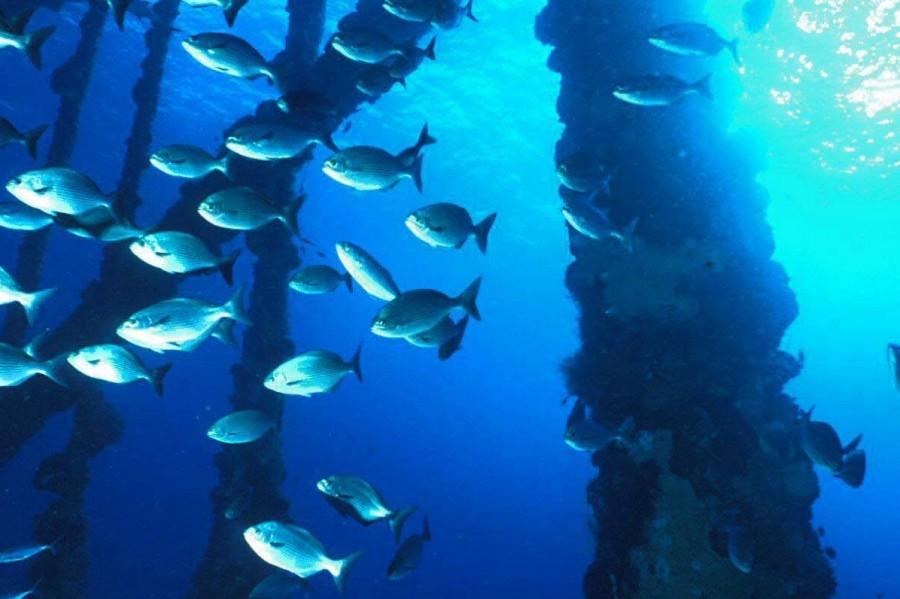The debated Rigs-to-Reefs policy ensures safety of marine animals
Save thousands of marine life creatures, or sell scrap metal. This is what the debate over Assembly Bill 2503, or the Rigs-to-Reefs movement, is asking. The obvious choice is the saving of the marine animals and their habitat. However, some people still see this pending decision as debatable.
On the coasts of Southern California, Marine animals have started to create a home using the oil industry drilling rigs that have become unusable for the companies. Thousands of marine fish now live in this unpredicted and naturally grown habitat that has sprung up around the supports of the oil rigs.
In previous laws, California demanded the removal of the oil rigs that were no longer usable one year after expiration (by the BSEE), but now an alternative of creating artificial reefs has floated to the surface. This includes either towing and toppling the rigs, replacing the rigs, or leaving just the underwater supports of the rigs standing. This in summary is the Assembly Bill of 2503, or the Rigs-to-Reefs law. However, Assembly Bill 2503 is not set in stone and it still a debate itself.
According to the Bureau of Safety and Environmental Enforcement, a typical four-leg structure provides two to three acres of habitat for hundreds of marine species. And a typical eight-leg structure provides a home for 12,000 to 14,000 fish, according to a study by the Coastal Marine Institute. This means if this law were to be passed, around 13,000 fish would continue to have a habitat. Keeping these animals alive and in their created habitat is a savior to the animals that have made the reefs their home.
One political standpoint is the loss of money by abandoning the rigs for future use. However, the cost of just removing these entire rigs speaks for itself that the Rigs-to-Reefs law will save oil and gas companies money.
According to the BSEE, the actual most common way to reclaim a site includes removing the superstructure and often selling it as scrap metal. This is known as “Idle Iron.” If the reusing of these rigs is out of the question, this entire debate is on saving an entire habitat with over 10,000 species of marine life, or selling scrap metal.
This debate is not just a political issue.
Some environmentalists believe that leaving just some of the structure there in order to secure the safety of the marine animals may affect the water at a future time. This is true and definitely something to consider in the future, but what these environmentalists need to realize is that that is an issue to solve if it happens in the future. In this situation California needs to weigh the scales. If they take out an entire naturally grown habitat for marine animals, they will kill many marine animals, and maybe save the water in that area but if they keep the structure until they are sure that the rig structures is creating these complications, they will save many marine animals from many unnecessary deaths.
Overall, taking out these rig structures is an issue for the present, and the debaters and environmentalists taking charge of this situation need to look at the now. And the now is that animals are living in this created coral, and ripping that away is ripping away their chance of survival, the home that they sustain themselves in. California cannot make that mistake until it is absolutely necessary.
And if this eventually does become necessary and the water is slowly being changed by the chemical compounds of the rigs, the current presence of the rigs will give environmentalists time to transport the animals to a habitat they can adapt to. This time would be in existent if this law does not pass.
by RACHEL MARQUARDT








![On the stage, Daniel Bozinovski and Rachel Treto play their part as Tom and Hannah in the show “The Cast List”. The show was about a group of students who were told about their cast list for the play “Romeo and Juliet.” The Theater I students were in preparation for their first showcase of the year. Students went over their lines during all of their class for the past two months. “[We put in] a lot of rehearsal, practicing lines, making sure you have everything memorized and making sure you are ready to go in and not forget anything,” Nathan Weeks said. Photo by Megan Kubas.](https://www.whitneyupdate.com/wp-content/uploads/2024/05/IMG_4085-600x396.jpg)
